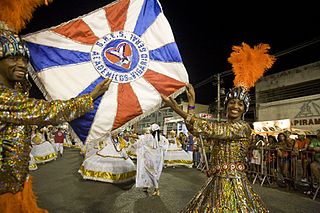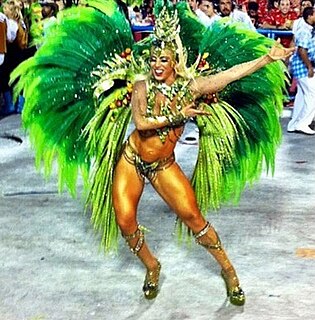Related Research Articles

Samba, also known as samba urbano carioca or simply samba carioca is a Brazilian music genre that originated in the Afro-Brazilian communities of Rio de Janeiro in the early 20th century. Having its roots in Brazilian folk traditions, especially those linked to the primitive rural samba of the colonial and imperial periods, is considered one of the most important cultural phenomena in Brazil and one of the country symbols. Present in the Portuguese language at least since the 19th century, the word "samba" was originally used to designate a "popular dance". Over time, its meaning has been extended to a "batuque-like circle dance", a dance style, and also to a "music genre". This process of establishing itself as a musical genre began in the 1910s and it had its inaugural landmark in the song "Pelo Telefone", launched in 1917. Despite being identified by its creators, the public, and the Brazilian music industry as "samba", this pioneering style was much more connected from the rhythmic and instrumental point of view to maxixe than to samba itself.

The Carnival of Brazil is an annual Brazilian festival held the Friday afternoon before Ash Wednesday at noon, which marks the beginning of Lent, the forty-day period before Easter. During Lent, Roman Catholics and some other Christians traditionally abstained from the consumption of meat and poultry, hence the term "carnival", from carnelevare, "to remove meat."

A samba school is a dancing, marching, and drumming club. They practice and often perform in a huge square-compounds and are devoted to practicing and exhibiting samba, an African-Brazilian dance and drumming style. Although the word "school" is in the name, samba schools do not offer instruction. Samba schools have a strong community basis and are traditionally associated with a particular neighborhood. They are often seen to affirm the cultural validity of the Afro-Brazilian heritage in contrast to the mainstream education system, and have evolved often in contrast to authoritarian development. The phrase "escola de samba" is popularly held to derive from the schoolyard location of the first group's early rehearsals. In Rio de Janeiro especially, they are mostly associated with poor neighborhoods ("favelas"). Samba and the samba school can be deeply interwoven with the daily lives of the shanty-town dwellers. Throughout the year the samba schools have various happenings and events, most important of which are rehearsals for the main event which is the yearly carnival parade. Each of the main schools spend many months each year designing the theme, holding a competition for their song, building the floats and rehearsing. It is overseen by a carnavalesco or carnival director. From 2005, some fourteen of the top samba schools in Rio have used a specially designed warehouse complex, the size of ten football pitches, called Samba City to build and house the elaborate floats. Each school's parade may consist of about 3,000 performers or more, and the preparations, especially producing the many different costumes, provide work for thousands of the poorest in Brazilian society. The resulting competition is a major economic and media event, with tens of thousands in the live audience and screened live to millions across South America.

The Carnival in Rio de Janeiro is a festival held every year before Lent; it is considered the biggest carnival in the world, with two million people per day on the streets. The first Carnival festival in Rio occurred in 1723. But in recent days, Kumbh Mela 2019 in Prayagraj, India had higher number of visitors per day and overall. It had approx. 30 million people visited on a single day and more than 120 million in overall.

Orfeu is a 1999 Brazilian drama film directed by Carlos Diegues, based on the play Orfeu da Conceição by Vinicius de Moraes. It retells the Greek legend of Orpheus and Eurydice, setting it in the modern context of Rio de Janeiro during Carnival. Toni Garrido stars as Orfeu, Patrícia França as Eurídice and Murilo Benício as Lucinho.

The Grêmio Recreativo Escola de Samba Unidos de Padre Miguel is a samba school of the city of Rio de Janeiro, being located on Rua Mesquita in the neighborhood of Padre Miguel. I came to present themselves among the great, in 1960, 1971 and 1972. After years in which they would wrap the flag gave back on top and Group A, in 2010. but with the addition made by LIERJ, where it originated the series to the school came to be a candidate for the title of this group.
The Liga Independente das Escolas de Samba de São Paulo - Independent League of the Samba Schools of São Paulo - or LigaSP is an entity that administrates the Special and Access Groups of the Carnival of São Paulo.

The Grêmio Recreativo Escola de Samba Portela is one of the most traditional samba schools of the city of Rio de Janeiro, and champion of the 2017 Carnival parade. It is the greatest winner of the top-tier Rio parade with 22 titles in total.
The Grêmio Recreativo Escola de Samba Acadêmicos do Grande Rio is a samba school of the Special Group of the carnaval of the city of Rio de Janeiro, being headquartered on Almirante Barroso street in Duque de Caxias.
The Grêmio Recreativo Escola de Samba União da Ilha do Governador was founded on March 7, 1953 by the friends Maurício Gazelle, and Quincas Orphylo, who were in Cacuia, the main site of the carnival parade of the Ilha do Governador, watching the presentation of small schools of samba and blocks of various districts of the island. It was then decided that the neighborhood of Cacuia should be represented by a samba school. Currently, the school is based in Estrada do Galeão in the neighborhood of Cacuia.
The Grêmio Recreativo Escola de Samba Acadêmicos da Rocinha is a samba school in Rio de Janeiro, located in the neighborhood of São Conrado on Bertha Lutz street.

Grêmio Recreativo Escola de Samba Unidos de Vila Isabel is a samba school in Rio de Janeiro. It was thrice champion of the Special Group and is currently headquartered in Boulevard 28 de Setembro in Vila Isabel.
The Liga das Escolas de Samba do Rio de Janeiro is the leading association that organizes the Série A Group in the Carnival in Rio de Janeiro.

Andrea de Andrade is a Brazilian Carnival Queen. She began performing in samba parades in 2006 with Mocidade, a samba school in Rio de Janeiro. In 2010 she won the "Rainha da bateria" of Mocidade and in 2011 led the parade of this school at the Rio de Janeiro carnival.
Grêmio Recreativo Escola de Samba Unidos do Viradouro, or simply Viradouro or Unidos do Viradouro, is a samba school that competes in the Carnival city of Rio de Janeiro. It is located in the Barreto neighborhood in Niterói.

The Grêmio Recreativo Escola de Samba Paraíso do Tuiuti is a samba school in Rio de Janeiro, located in the neighborhood of São Cristóvão.
Grêmio Recreativo Escola de Samba Unidos do Porto da Pedra is a samba school currently headquartered in the municipality of São Gonçalo. The school was previously located in the city of Rio de Janeiro.
The Grêmio Recreativo Escola de Samba Estácio de Sá is one of the most traditional samba schools of the city of Rio de Janeiro. It has won once the top-tier Rio parade in 1992.
This page are listed the results of all of the Rio Carnival on year 2012. In that year the LESGA was relieved by RioTur. due disrespecting the regulation of the parade of Grupo de acesso that before the counting was defined that none of the school would be demoted. Due to lack of passthrough of money the time of parades and the uncertainties as to the location of the barracks of schools that have been evicted from Carandiru. Soon after this Carnival LIERJ was created, whose unified groups A and B, pra form the Serie A.

LIESB and ACAS are the alloys of carnival that organize the parades conducted outside the Marquês de Sapucaí. The LIESB took over the organization of the lower level divisions'. In 2015, disagreements on the board of AESCRJ led the organization to suffer intervention by RioTur on the eve of the carnival. because of this, after the carnival that year came the LIESB and Samba é Nosso. where twelve of fourteen guilds of the Série B decide founded the LIESB and part of the samba schools Série B and all schools of Series C, D, E in Samba é Nosso.
References
- ↑ "Desfiles dos Grupos B, C e D serão organizados pela Lierj". Galeria do Samba. 2015-01-08. Retrieved 2016-10-27.
- ↑ "Intendente: Liesb e Samba é Nosso efetivam sorteio da ordem dos desfiles". STZD. 2015-09-18. Retrieved 2016-10-27.